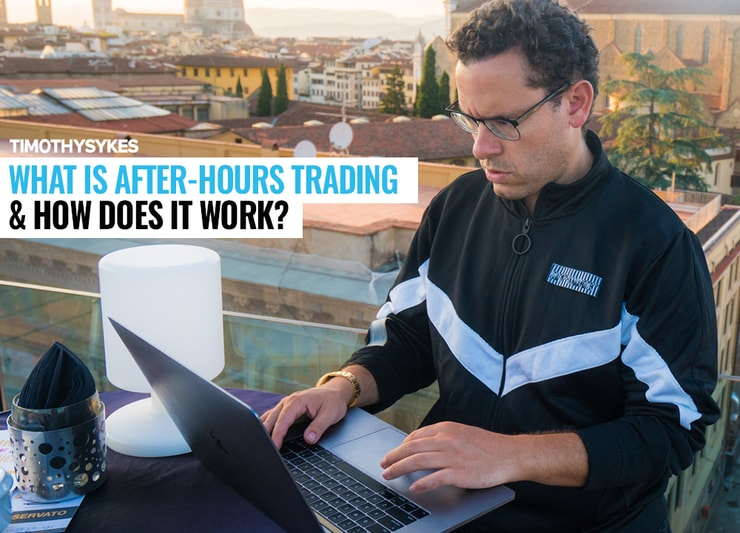After-hours trading isn’t for the faint of heart…
If you’re just starting out as a stock trader, one of the first things you need to know is when to trade.
Trading exchanges are the same as any other marketplace: they have opening and closing times. Traders need to know when to show up and when to leave, right?
But there are exceptions to the market open and close now. That’s what we call after-hours trading. So today, I’ll answer two questions:
- What is after-hours trading…
- And how does it work?
I’ll also go into after-hour market times and some pros and cons of trading after hours.
Keep in mind, there’s a good reason that the market isn’t open 24/7. More on that in a bit…
Table of Contents
- 1 What Is After-Hours Trading?
- 2 How Does After-Hours Trading Work?
- 3 Benefits of After-Hours Trading
- 4 Risks of After-Hours Trading
- 5 After-Hours on the Nasdaq
- 6 Examples of Biggest After-Hours Movers
- 7 Tips for After-Hours Trading
- 8 Brokers for After-Hours Traders
- 9 Finding the Most Volatile Stocks With After-Hours Volume
- 10 Frequently Asked Questions About After Hours Trading
- 11 Conclusion
What Is After-Hours Trading?
So if the markets have regular business hours — what is after-hours trading? After-hours trading is trading outside the regular market hours of 9:30 a.m. to 4 p.m. Eastern.
Trading is available before the market open, called premarket. Trading after the market close is called post-market.
After-hours trading is the combination of post-market and premarket trading. It’s everything that occurs in the short time period before the market opens and right after it closes.
Post-Market and Premarket Trading
After-hours and premarket trading are essentially the same thing: extended trading hours.
But don’t think you can trade in these sessions like you would during a standard trading day. Your decisions can vary depending on whether you trade in the morning or evening.
In most cases, premarket trading hinges on information that came out overnight. Traders who get up early may read reports, learn fresh developments, and decide to pounce.
After-hours trading involves capitalizing on stock price movements during the day. But it can also be traders moving on anticipated news or economic indicators for the next morning.
If you’re planning to hold a stock overnight, you gotta do your research. You want solid indicators that the stock will perform as you expect — whether you’re going long or shorting.
How Is Late-Day Trading Different From Trading in the After-Hours Market?
Late-day trading is buying or selling shares before the regular market closes for the day.
The stock market tends to be more volatile later in the day than in the after-hours market. This is when traders and investors close out positions or spot stocks to buy and hold overnight. There can be a rush to make quick decisions before time runs out.
Then, there’s a cooling-off period … The exchange closes. Most investors head home, and volatility reduces sharply. But some people continue to play in after-hours trading.
This is different from late trading…
You may have heard of late trading mutual funds — it’s illegal. Don’t confuse the two. Late trading typically refers to hedge funds reporting mutual-fund buys or sales during market hours that actually occurred after hours.
Mutual fund prices are set each day and don’t change intraday. You can see how scammers would try to benefit from this illegal practice by taking advantage of a previous day’s price.
How Does After-Hours Trading Work?

2025 Millionaire Media, LLCAfter-hours trading happens outside regular market hours … so how does it work?
After-hours trading is available thanks to improved technology. All orders are run through Electronic Communication Networks (ECNs). These are computers that match up buy and sell orders, as long as they’re the same price.
To get executed, all order prices must be limit orders. You can’t select a market order since the market’s closed. You have to specify an electronic securities exchange, such as NYSE Arca. You also need to use the right order type, such as good ‘til extended market (GTEM).
More Breaking News
- Sonnet BioTherapeutics: Analyzing the Recent Surge
- BULL Anticipates Strong FY Earnings Amid Strategic Moves
- TeraWulf Stock Surges Amid Strategic Collaborative Shift
What Can You Trade?
After-hours trading works differently depending on your broker. Brokers set their own rules about what types of trades you can make, what hours constitute after-hours trading, and whether you have to pay extra fees. We’ll get into that more shortly.
For now, know that you can buy, sell, and short stocks much the same as you would during the day. Keep in mind you need to be extra careful.
Market Hours Schedule
Here are the hours for the major U.S. stock exchanges:
- Regular market hours are 9:30 a.m. to 4 p.m. Eastern time, Monday through Friday — except federal holidays.
- Pre-market trading allows you to start as early as 4 a.m. Eastern until the market open.
- After-hours trading times allow you to trade from 4:30 p.m. until 8 p.m. Eastern.
If you’re trading at 7 a.m. or at 5:30 p.m., you’re trading after hours.
There’s nothing wrong with that. But you gotta know the rules as well as a few drawbacks. Read on to better understand the risks and potential benefits of after-hours trading.
Who Can Trade During the After-Hours Session?
After-hours stock trading used to only be available to the institutional investors. But thanks to computerized executions, it’s now available to retail traders.
You can trade after hours as long as your broker allows it. If you have an active trading platform through your broker, you can select the order types for the trades.
Some brokers don’t allow aftermarket trading. Some might charge extra fees for the privilege. Executions can also be tougher in the aftermarket, due to less liquidity. There’s a chance your order may not even be executed.
After-Hours Options Trading
In most cases, you’re limited to buying, selling, and shorting stocks after hours. Most brokers don’t allow after-hours options trading. The same can be true for futures and complex plays.
The after-hours trading market typically only includes unconditional trades.
Does After-Hours Trading Effect the Opening Price?
It depends. After-hours trading can affect a stock’s opening price…
If a stock releases earnings or good news after market hours or in pre-market, and there are a lot of buyers, the price can go up based on demand.
When the market opens, the stock can open at the price it ended at in premarket. It could be substantially higher than the previous day’s closing price. That premarket price can also collapse fast in the regular session.
The same is true if bad news is released. Selling pressure can increase after hours. The next opening price may be lower than the previous close.
Be cautious about price movements in the post- and premarket. What the price does during regular market hours can be totally different than in after-hours sessions. Don’t assume a trend will continue in the regular session.
Remember, after-hours trading only represents a small percentage of the overall market sentiment.
Benefits of After-Hours Trading
Those of you familiar with me know I’m all about opportunities.
So does after-hours trading offer more opportunities? It depends. Buying stocks outside the regular trading hours can mean a chance to get in early on swings…
But … (there’s always a but) … it’s riskier.
When can these trades work better? Earnings winners can be one example.
But if you want to play this risky market, you gotta do your homework. Keep up with the news and look for any catalysts.
Aside from earnings reports, a catalyst could be global news, new legislation, or a new product launch. It can be anything that sparks a big move in the stock — up or down.
But again it’s risky. I think it’s better to find consistency in the regular markets before you try trading after hours. There’s less volume, for one. You can get stuck in trades, especially if stocks don’t do what you expect when the market opens.
Learn the market basics. Start with this book by my student Jamil: “The Complete Penny Stock Course.” It covers so many questions I get from newbies all the time. Get it. Read it. Use it.
Risks of After-Hours Trading
Yep, trading after-hours is risky, especially if you don’t do thorough research.
For earnings calls, you need to listen to what the execs say. This can swing stock prices fast.
But stocks that fly high can fall just as big and fast. Especially on earnings reports or major negative moves. Riding this roller coaster is tricky. Don’t just act on the first media report you read.
Other risks to consider when trading in the pre- and post-market…
For one, you’re generally dealing with low liquidity. If you need to close out a position fast, you might not have the option. There may not be any buyers or sellers.
Second, after-hours trading quotes are limited, and the bid-ask spreads tend to widen during these hours.
Also, only limit orders are accepted in after-hours trading. To get executed you need to hit the bid or ask. That may result in paying more or selling for less than you wanted. Or you can just hope someone will buy or sell on your limit order. I’m not a big fan of holding and hoping.
After-Hours on the Nasdaq
You can check out the Nasdaq-100 Pre-Market Indicator.
This is Nasdaq’s gauge of market sentiment before the market opens. And because we have much better data available these days, this can offer a bigger snapshot. It’s based on real after-hours trading data.
But you can’t always rely on data. It’s not technically delivered in real-time and it’s not always accurate. As always, do your research for every single trade.
Examples of Biggest After-Hours Movers
Certain stocks are known to experience lots of activity in the after-hours market. Here are three examples of after-hours movers.
AMZN After Hours
It’s no huge surprise that Amazon (NASDAQ: AMZN) after hours is active — long after the exchanges close. Part of this is due to the fact that it’s a major international corporation. It does business at all hours. But it’s also because it sometimes experiences unexpected price movements.
The Dow After Hours
The same is true for the Dow Jones Industrial Average. This index includes 30 of the largest corporations. It’s bound to see activity during both premarket and after-hours trading.
AAPL After Hours
Then there’s Apple (NASDAQ: AAPL). This is a beloved brand worldwide. And that adoration extends to its stock. Apple shares can see an after-hours trading boost based on news of — you guessed it — a new iPhone.
Tips for After-Hours Trading
After-hours markets are different from the regular markets. So what can help you make a trading decision premarket or after hours?
If you’re looking at penny stocks with higher volatility, pay attention to earning releases and news events.
Earnings reports tend to come out before the market opens and after it closes. That’s why after-hours trading can be more exciting.
When earnings come out they can result in major price movements. And not all traders are paying attention…
But I never try to predict how much or if a stock will move on earnings or news.
Be alert and know what’s going on, but wait for the reaction. Pay attention to how the market responds and be prepared to move if the setup is right for your strategy.
How to Analyze After-Hours Stock Prices
Stock charts are your best friend when it comes to trading. After-hours trading is no different. Learn to read charts.
It’s how you can see what a specific stock has done in the past — the includes previous after-hours markets. Has it held its price overnight for the most part? Do any specific catalysts tend to make it break out once the market closes?
History matters when you’re trading. That’s why I have over 6,000 videos available. My goal is to help my students be smarter, self-sufficient traders.
Start your trading education today and subscribe to Pennystocking Silver.
Analyzing After-Hours Stock Charts
Why is analyzing after-hours stock charts important?
If a company releases news after hours, it’s key to analyze the chart for the market’s reactions.
My strategy involves looking at the biggest percent gainers. So I want to see any stocks that are up in the post-market or premarket. After the market closes, I run a scan for the biggest percent gainers. I run them again in the premarket.
I also check the news for potential catalysts. I analyze the stock charts for patterns and support and resistance levels. Again, I don’t like to trade after hours. It’s too illiquid…
I prefer to wait until the regular market hours to see how the market reacts. I want to see if the pattern fits my setup and how the trade ranks on the Sykes Sliding Scale. (Hint: that’s part of the Trader Checklist. If you have a Profit.ly account, you can watch the original Trader Checklist guide here.)
Get access to my FREE penny stock guide here.
Brokers for After-Hours Traders
Now let’s talk brokers. After-hours rules aren’t the same as they are for regular trading hours. Don’t skimp on your research. Be careful when you choose a broker.
If after-hours trading is a service you think you need from your broker, make sure you understand the rules. Every broker has different restrictions, fees, and rules.
Some brokers charge extra fees for after-hours trading. It may seem small, but if you purchase a lot of shares, it adds up.
You also might be limited in the types of trades you can execute. Most allow you to buy, sell, and short stocks, but they don’t allow stop orders or conditional trades.
Vet your broker. Find the one that best fits your trading strategy. (I trade with these rules and use these brokers.)
1.) Robinhood
Not gonna lie, I’m not the biggest fan of this broker. Robinhood may have mass appeal due to its commission-free trading app … but it has major issues with customer service. Check out my full review of Robinhood here.
And you can’t trade after hours with Robinhood unless you choose its gold package — which isn’t free. And keep in mind that its executions can lag, which can ultimately cost you.
Free doesn’t equal good. Usually the opposite is often true. I’m happy to pay commissions for good executions and customer service.
2.) TD Ameritrade
TD Ameritrade is one of my preferred brokers. This is a well-known, established company.
This broker allows after-hours trading from 4:02 p.m. until 8 p.m. Eastern. It also offers 24-hour trading five days a week on certain securities.
3.) Fidelity
Fidelity’s pre-market trading is available from 7 a.m. to 9:28 a.m. Eastern. Its after-hours runs from 4–8 p.m. Eastern.
The FAQ page on its website explains its rules and answers a lot of questions about after-hours trading.
Finding the Most Volatile Stocks With After-Hours Volume
Volatility can be a sign that you’ve found a good candidate for after-hours trading…
But that can’t be the only thing you look at. Check out the charts. Look at several news sources. Maybe it all adds up … but you still gotta have the volume.
You can check all that with the right tool. I like to use StocksToTrade. I helped design this trading platform. It’s a great way to find high-volume and volatile stocks for your watchlist.
Get my FREE weekly stock watchlist here.
Apply for the Trading Challenge
Ready to become a self-sufficient trader? Apply for my Trading Challenge.
Heads up: it’s not easy and not everyone is accepted. I’m looking for only the most dedicated students. You’ll get access to tons of videos, webinars, a chat room, and more. You won’t just learn from me — you can also learn from some of my top students.
My goal is to be the teacher I never had. When I started trading, this kind of education wasn’t even possible … buy you gotta work your butt off for it. No lazy losers, please.
Think you can make the cut? Apply today.
Frequently Asked Questions About After Hours Trading
What is After-Hours Trading?
After-hours trading and pre-market trading occur during hours directly before and after the market’s regular hours of 9:30 a.m. to 4 p.m. EST, Monday through Friday, except for holidays. The actual times may vary depending on your broker, but typically pre-market trading can run from as early as 4 a.m. until the market open, and after-hours trading usually runs until 8 p.m.
How Does After-Hours Trading Work?
After hours trading orders are run through Electronic Communication Networks (ECNs) — computers that match up buy and sell orders. All after hours orders have to be limit orders, since the market isn’t open.
Who Can Trade During the After-Hours Session?
As long as your broker allows it and has a platform, anyone can trade during the after hours session.
Does After-Hours Trading Affect the Opening Price?
It depends. For example, if there’s a huge catalyst after hours or in the pre-market that attracts a ton of traders, the price can go up based on demand. However, you can never assume that a trend is going to continue in the regular session since after-hours trading only represents a small portion of the market sentiment.
Is After-Hours Trading Risky?
Yes. Low liquidity, a lack of buyers and sellers, and bigger bid-ask spreads make trading after hours trading far riskier than trading during regular hours. I rarely trade outside of regular market hours.
Conclusion
Is it worth it to trade after hours? It’s pretty risky. And it’s really about your personal strategy.
What I think is smarter is to watch these sessions to see how the big gainers (or losers) move. Don’t bank on anything. Wait for the market to react. What seems like a solid trade collapse in seconds at the market open.
So stay safe. Follow rule #1 and always cut losses quickly.
Learning how the stock market works can seem daunting. Trust me, I’ve lived it. And I’m still learning to be a better trader. That’s the thing with trading, your education never really ends.
Keep learning, researching, and practicing. Learn from your mistakes. And when you’re ready, come join me in the Trading Challenge.
What do you think about after-hours trading? Let me know in the comments … I love to hear from you!











Leave a reply